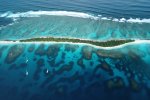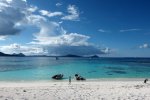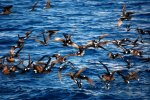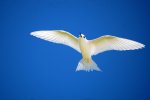Around Planet Ocean - we're circumnavigating our blue home to ...
- raise awareness for the value of ocean ecosystems
- promote acceptance of protected areas
- educate stakeholders
- support and enable research and citizen science projects
Interested? Come and sail with us - or just drop us a line ...
SAILED ROUTE since 2014:
PLANNED ROUTE:
-
(1) Feb.-Apr. 2024: Baja California
-
(2) May-July 2024: Marquesas
-
(3) Aug.-Sep. 2024: Tuamotus
-
(4) Oct.-Nov. 2024: Tahiti, Moorea
-
(5) Dec. 2024: Australs, Rapa?
-
(6) Jan.-Mar. 2025: Gambier
-
(7) westwards: Kiribati, Cooks, Marshalls, Micronesia, Papa New Guinea, Indonesia, ...
-
BLOG:
20.03.2021 - The birds of Kouaku, Gambiers Islands
Kouaku is the southernmost little sandy island - Motu - in the Gambiers. The vegetation consists mainly of native shrubs and trees with only a few coconut trees. If you go ashore you are welcomed by lots of noddies and terns, which circle above you. This is because if you wander closer the birds get agitated and circle above after giving a warning signal to the other birds. Especially if it is a nesting area. Normally only a few birds fly around the motu or sit in groups on the sandy beach. We always love to find islands where there are still a lot of birds.
There are mainly two different bird species on Kouaku, which also use the island as nesting area. The wonderful, brilliant white White Terns (Gygis alba) as well as the Black Noddies (Anous minutus). We also saw some Brown Noddies (Anous stolidus) and Red-footed Boobies (Sula sula). Most seabirds simply nest on the ground, some building nests, others just laying there eggs in a sandy hollow. This was not a problem before people together with their animals arrived on those oceanic islands. Cats, dogs, pigs, goats and rats pose a severe threat to seabird populations. The arrival of humans and their intentional and unintentional introduction of animals now prevent the successful nesting of seabirds in a lot of places, since the eggs and chicks are easy prey for both, humans and animals.
White terns and noddies do not nest on the ground but use shrubs and trees. The black noddies look similar to the brown noddies but are a little smaller and have a longer and straighter beak. The name noddy comes from their mating behavior, because they always nod with their heads during courtship. They feed on small fish and squid and usually hunt in bigger groups. If big fish drive a school of small fish towards the surface, noddies will see this and start catching fish from above. As soon as we see a big group of noddies above the water we know there must be a lot of fish around.
Noddies build small nests on branches of shrubs and trees, which consist of twigs, leaves and bird excrements. They use the same nest more than once and always lay only one egg. The chicks look similar to the adults, dark brown with a white cap on their head. Once in a while a chick might fall out of the nest or tree and hide on the ground. Luckily we observed that those chicks are still fed by the parents.
In contrast, the white terns also nest on trees but do not build a nest. They lay their single egg simply on a branch. The advantage is that the eggs can not be attacked by nest parasites, but the disadvantage obviously is that the eggs and later chicks can easily fall down in stronger winds. Luckily they can lay another egg pretty quickly if this happens. Therefore the chicks already have highly developed feet to hold on to branches. On Kouaku we can observe everything from eggs to freshly hatched chicks up to almost grown ones. If you get closer to a chick they tend to remain completely still and try to melt into their surroundings. Some look like small owls sitting in the tree. Once in a while you can watch how they are fed with small fish by their parents. If they are freshly hatched they have the same grayish color as the bark of the trees. When they grow, the feathers become more and more white until they are brilliant white when they are grown and often reflect the blue of the ocean surface when they fly. White terns tend to live very long. One individual is known to be be at least 42 years old, which is remarkable for a small sea bird.
In the evenings we usually also see red-footed bobbies (Sula sula) resting in the trees. But if they nest around Gambier we do not know. At least we have never seen nests anywhere. There are also other bird species in the Gambier islands. On some of the southern islands the rats were eradicated and artificial nesting sites created to attract other sea birds (petrels and shearwaters) and give them a safe place to nest.
We are glad that there are at least a few places where you can find an abundance of birds. Those islands need some prerequisites like no disturbance through humans (collecting eggs, hunting birds), no or only very few coconut trees, because those can not be used for nesting or as shelter, as well as the absence of rats and other predators of their eggs and chicks. Also, humans are a threat since many still collect eggs. Lately studies have found that bird islands are very important for the health of coral reefs since the birds bring nutrients - in form of fish and squid - from big ocean areas to the islands and improve the growth of plankton through their excrements, which enhances the food supply for fish and other marine organisms close to the island. Bird islands are important for the ecosystem ocean and so we are always happy to find special places like this.
- 20.02.2020 - Galapagos to Rapa Nui: always something ...
- 11.10.2019 - Underwaterwonderworld Revillagigedos
- 25.05.2019 - Amazing Bird Island in the Gulf of California
- 20.05.2019 - In the middle of the Sea of Cortez – Isla San Pedro Martir
- 13.08.2018 - The Elephant Seals of San Miguel, Channel Islands, California
- 30.06.2018 - Turtle-soup a la Maui
- 30.05.2018 - Welcome to Hawai'i
- 25.10.2017 - First time on the hard since 4 years
- 01.09.2017 - Staying in Paradise: Tahanea
- 10.07.2017 - Natural wonders in the Tuamotus
- 27.04.2017 - Easter Island: Stopover at the Navel of the World
- 30.03.2017 - Tropics greet Antarctica in Isabela
- 14.03.2017 - Cactus forest and giant tortoises on Santa Cruz
- 02.03.1017 - Galapagos Islands: Incredible encounters at San Cristobal
- 01.03.2017 - Galapagos: fantastic diving
- 09.02.2017 - Let´s go to Galapagos!
- 29.09.2016 - Through the Panama Canal into the Pacific!
- 21.08.2016 - We are sailing everyday in Kuna Yala...
- 3.2.2016 - stopover at Robben Island, the ocean is calling!
- 08.03.2016 - A long way to go
- 05.03.2016 - Magic Nights
- 02.03.2016 - Of Crabs, Birds, Cats and Rats
- 28.02.2016 - Ascension: Volcanic Island in the middle of the Atlantic
- 26.01.2016 - We love Penguins
- 20.12.2015 - Work Stop South Africa
- 10.12.2015 - The turtles of Sodwana Bay
- 20.11.2015 - First storm in South Africa
- 20.10.2015 - Short stop in Bazaruto, Mosambik
- 16.10.2015 - On the open ocean again, bye, bye Madagsacar!
- 14.10.2015 - Maramba Bay or Bay of Parrots
- 06.10.2015 - Iles Glorieuses: There and Back Again
- 20.09.2015 - Nosy Hara, Island of little wonders
- 19.09.2015 - Nosy Hao: Turtle nests wherever you look
- 10.09.2015 - The singing whales of Ile Ste. Marie
- 24.08.2015 - hiking and nature paradise Reunion
- 20.08.2015 - stunning La Reunion: 360° panoramas
- 30.07.2015 - pics of Mauritius now online
- 29.07.2015 - Mauritius - special animals and one great anchorage
- 29.07.2015 - The secret of the rusty boats
- 28.07.2015 - Mauritius - lots of people and even more sugar cane
- 06.07.2015 - Rodrigues - leasurely paradise
- 04.07.2015 - pics of Rodrigues now online
- 30.05.2015 - pics from Chagos and Maldives now online
- 25.05.2015 - wittnessing death (and a little recovery): Coral Bleaching Event at Chagos, BIOT
- 24.05.2015 - A wonderful world for seabirds
- 20.05.2015 - Mantas of Salomon
- 21.04.2015 - Off to Chagos!
- 19.04.2015 - Coral gardens of the Maldives
- Encounters with marine mammals
- Feeding Frenzy!!
- Manta ID - Individual Identification of Manta Rays
- Dhangethi - Local island inside the whaleshark sanctuary
- Fishhead - fish, fish and some more fish
- "Manta-Spa"
- Male' – skyscrapers and motorcycles
- Giants of the sea
- Go west - whales and atolls are waiting
- Merry Xmas and happy 2015!
- Merry Christmas!
- Lets go to Phuket
- Always something happening in Langkawi
- A labyrinth of mangroves in Langkawi
- Busy in Langkawi
- Adventures between Penang and Langkawi
- Strait of Malakka - again: Singapore to Penang
- Bye bye Johor Bahru!
- Planet Ocean Videos
- 23.3.-2.4.2014 - The Andamans (3) - Barren Island - A dream made of ashes
- 11.3.-21.3.2014 - The Andamans (2) - Coral cemetery and plenty of lonely beaches
- 2.3.-10.3.2014 - The Andamans (1) - 150 pages of bureaucracy but no other boats around
- The southwest of Thailand – massage, sandy beaches, corals and lots of islands
- Sonnen-Antriebs-Test
- Tok-tok, Tok-tok
- November 2012 - der Umbau startet!
- Überstellung Endspurt - Penang nach Phuket
- Überstellung 3. Etappe - Durch die Malakkastrasse nach Penang
- Überstellung 2. Etappe - vorbei an Singapur
- Erstes großes Abenteuer mit 'Pakia tea' - Überstellung nach Phuket, 1. Etappe
- Fotos Segeln Dezember 2010 - Jänner 2011
- Segeln Dezember 2010 - Jänner 2011
- Wharram "Melanesia" Nr. 673 "VELELLA" ist fertig!
- Bootsbau: Auslegerkanu Wharram "Melanesia"
- Segeln mit Freunden
- Wir kaufen uns ein Schiff!







.jpg)
_and_chick_observing_their_surroundings.jpg)













_sitting_on_the_egg.jpg)























 >>planned route - join us ...
>>planned route - join us ...